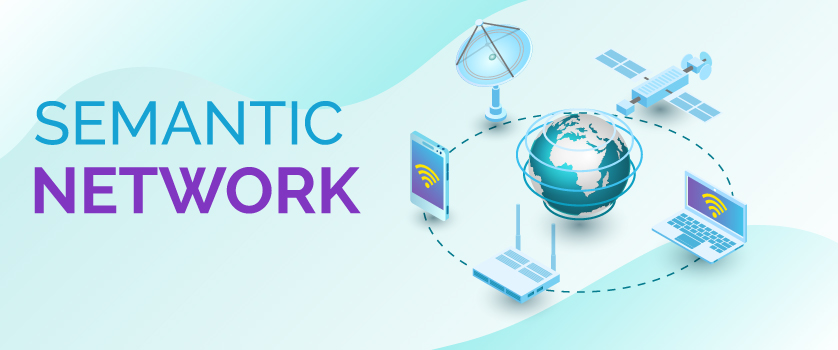
Anshul Jain
23 Apr 2020
Knowledge Representation, as we discussed in our previous article, is an integral part of Artificial Intelligence (AI). It works along with Reasoning to enable machines to comprehend and represent accumulated data and knowledge in a reasoning way. It is concerned with thinking and how it contributes to intelligent machines. Moreover, it uses various techniques to accomplish an accurate representation of knowledge. These techniques are:
- Logical Representation.
- Semantic Networks.
- Production Rules.
- Frames Representation.
It is one of these techniques, Semantic Networks, that we are going to discuss in detail today, by answering various critical questions associated with it, like defining the principles of semantic networks;
- What do you mean by semantic networks?
- What is the difference between Semantic Nets and Frames? etc.
But, let’s begin the discussion by answering the most crucial question:
What are Semantic Nets in AI?
Semantic Networks or Semantic Net is a knowledge representation technique used for propositional information. Though its versions were long being used in philosophy, cognitive science (in the form of semantic memory), and linguistics, Semantic Network’s implementation in computer science was first developed for artificial intelligence and machine learning. It is a knowledge base that represents concepts in a network and the systematic relations between them.
Semantic Network is a directed or undirected graph consisting of vertices. These vertices represent concepts and edges, which further represent semantic relations between concepts, mapping or connecting semantic fields. Moreover, it is termed as Associative Networks, as it processes the knowledge about accepted meanings in adjacent regions.
Semantic Network Examples:
Some of the examples of Semantic Networks are:
- WordNet: A lexical database of English that groups English words into sets of synonyms (synsets), provides definitions, and records semantic relations between them.
- Gellish Model: It is a formal language that is defined as a network of relations between concepts and names of concepts.
- Logical Descriptions: Semantic Networks can also be used to represent logical descriptions like Charles Sanders Peirce’s existential graphs or John F. Sowa's conceptual graphs.
Components of Semantic Networks:
Semantic Networks can further be defined by specifying its fundamental components, which are:
- Lexical Components - Consists of:
- Nodes represent the object or concept.
- Links: Denoting relation between nodes.
- Labels: Denoting particular objects & relations.
- Structural Component - Here the links and nodes form a directed graph wherein the labels are placed on the link and nodes.
- Semantic Component - The meanings here are related to the links and labels of nodes, whereas the facts are dependent on the approved areas.
- Procedural Part - The creation of new links and nodes is permitted by constructors, whereas the destructors are responsible for the removal of links and nodes.
Semantic Network Architecture:
As stated earlier, the semantic network is a simple knowledge representation technique. It uses graphic notation to represent knowledge or data, wherein a graph of labeled nodes and labels are used, with directed arcs to encode knowledge. It follows a simple and comprehensible architecture, which helps add and change information efficiently.

Types of Semantic Networks:
Semantic networks were developed initially for computers in 1956 by Richard H. R. of the Cambridge Language Research Unit (CLRU), for machine translation of natural languages. However, now it is used for a variety of functions, like knowledge representation. There are currently six types of semantic networks that enable declarative graphic representation, which is further used to represent knowledge and support automated systems for reasoning about the knowledge. These six types of semantic networks are:
- Definitional Networks: Emphasize the subtype or is-a relationship between a concept type and a newly defined subtype.
- Assertional Networks: Designed to assert propositions.
- Implicational Networks: Uses implications as the primary relationship for connecting nodes.
- Executable Networks: Contain mechanisms that can cause some change to the network itself.
- Learning Networks: It builds or extends the representation by acquiring knowledge from examples.
- Hybrid Networks: These combine two or more of the previous techniques, either in a single network or in separate, but closely interacting networks.
Application of Semantic Networks:
With the growing need for intelligent machines, the application of semantic networks is also increasing. Therefore, listed here are some of the areas where Semantic Networks are applied or used:
- In natural language processing applications like semantic parsing, word sense disambiguation, etc.
- Specialized retrieval tasks, like plagiarism detection.
- Knowledge Graph proposed by Google in 2012 uses semantic networks in the search engines.
Advantages & Disadvantages of Semantic Networks:
As one of the oldest and the most effective techniques or Knowledge Representation, semantic networks offers various advantages, a few of which are:
1. Advantages:
- It is simple and comprehensible.
- Efficient in space requirement.
- Easily clusters related knowledge.
- It is flexible and easy to visualize.
- It is a natural representation of knowledge.
- Conveys meaning in a transparent manner.
2. Disadvantages:
Though the importance of Semantic Networks is immense in Knowledge Representation, we must consider the drawbacks it offers, such as:
- Inheritance cause problems.
- Links on objects represent only binary options.
- Interactable for large domains.
- Don’t represent performances or meta-knowledge effectively.
- It’s difficult to express some properties using Semantic Networks, like negation, disjunction, etc.
Difference between Semantic Nets and Frames:
Semantic networks and frames are both knowledge representation techniques. Though they are categorized into the same group, their functions and working are vastly different from one another. Therefore, to help you understand the differences between the two, we are here with a detailed comparison of semantic nets and frames.
Semantic Nets
- A knowledge-base that represents systematic relations between concepts in a network.
- It has nodes that represent objects and arcs and describes their relations.
- With Semantic Networks, adding information and making inferences is fast and easy.
- It categorizes objects in different forms and also links them.
- Semantic networks vary in type and can represent very diverse systems.
Frames
- Represent related knowledge about a narrow subject that has default knowledge.
- It has slots that further have values, which are known as facets.
- Frames add a procedural attachment & inherit properties from generic frames.
- It makes the programming languages easier by grouping the related data.
- It is vastly used in natural language and information processing.
Conclusion:
In the field of artificial intelligence, problem-solving and knowledge representation can be simplified with a suitable knowledge representation technique, and the semantic network model is the most appropriate, as it captures and encapsulates a vast amount of information entering an intelligent environment and improves the expressive power of intelligent machines. Moreover, its nature enables adding and changing the information in localized and clear-cut, inference generation extremely efficient.




